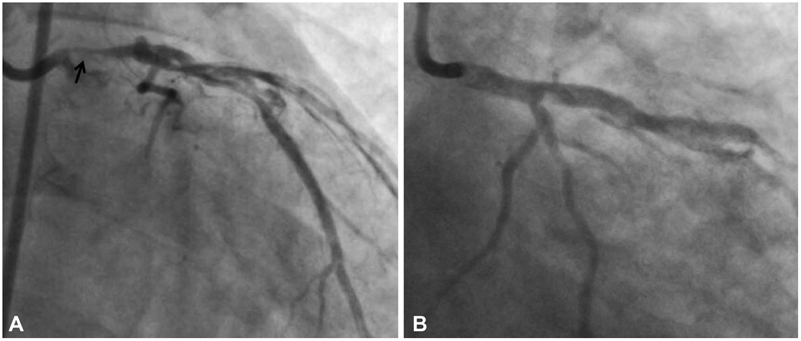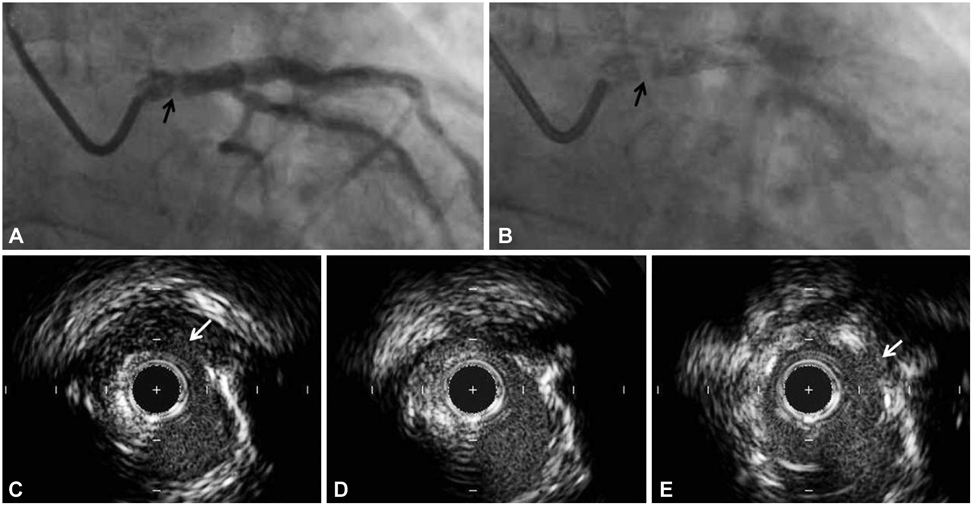Korean Circ J.
2011 Dec;41(12):763-765. 10.4070/kcj.2011.41.12.763.
Stent Fracture at the Proximal Shaft of the Left Main Stem
- Affiliations
-
- 1Department of Internal Medicine, Seoul St. Mary's Hospital, College of Medicine, The Catholic University of Korea, Seoul, Korea. kbseung@catholic.ac.kr
- 2Cardiovascular Center and Cardiology Division, Seoul St. Mary's Hospital, College of Medicine, The Catholic University of Korea, Seoul, Korea.
- KMID: 1776255
- DOI: http://doi.org/10.4070/kcj.2011.41.12.763
Abstract
- Stent fracture is likely to be caused due to mechanical stress at the hinge point or kinking movement at the point of aneurysm formation with stent malapposition. To our knowledge, this is the first published report of stent fracture at the proximal shaft of the left main stem in a patient with acute myocardial infarction.
Figure
Reference
-
1. Aoki J, Nakazawa G, Tanabe K, et al. Incidence and clinical impact of coronary stent fracture after sirolimus-eluting stent implantation. Catheter Cardiovasc Interv. 2007. 69:380–386.2. Lee MS, Jurewitz D, Aragon J, Forrester J, Makkar RR, Kar S. Stent fracture associated with drug-eluting stents: clinical characteristics and implications. Catheter Cardiovasc Interv. 2007. 69:387–394.3. Doi H, Maehara A, Mintz GS, et al. Classification and potential mechanisms of intravascular ultrasound patterns of stent fracture. Am J Cardiol. 2009. 103:818–823.4. Hong MK, Mintz GS, Lee CW, et al. Late stent malapposition after drug-eluting stent implantation: an intravascular ultrasound analysis with long-term follow-up. Circulation. 2006. 113:414–419.5. Aoki J, Kirtane A, Leon MB, Dangas G. Coranary artery aneurysm after drug-eluting stent implantation. JACC Cardiovasc Interv. 2008. 1:14–21.6. Lee SY, Im E, Yang WI, Kim JS, Cho YH, Shim WH. A sirolimus: eluting stent fracture combined with a coronary artery aneurysm. Korean Circ J. 2008. 38:69–71.7. Tizón-Marcos H, De Larochellière R, Larose E. Breakpoint: left main stent fracture: review of the literature. J Interv Cardiol. 2009. 22:362–367.8. Adlakha S, Sheikh M, Bruhl S, et al. Coronary stent fracture: a cause of cardiac chest pain? Int J Cardiol. 2010. 141:e23–e25.9. Bergelson BA, Tommaso CL. Left main coronary artery disease: assessment, diagnosis, and therapy. Am Heart J. 1995. 129:350–359.10. Kim EJ, Rha SW, Wani SP, et al. Coronary stent fracture and restenosis in the drug-eluting stent era: do we have clues of management? Int J Cardiol. 2007. 120:417–419.11. Liao R, Green NE, Chen SY, et al. Three-dimensional analysis of in vivo coronary stent: coronary artery interactions. Int J Cardiovasc Imaging. 2004. 20:305–313.
- Full Text Links
- Actions
-
Cited
- CITED
-
- Close
- Share
- Similar articles
-
- Coronary Stent Fracture in a Patient with an Atrial Septal Defect and Severe Pulmonary Hypertension
- Treatment of conuninuted Segmental Fracture of the Proximal Tibial Shaft with Retrograde Ender Nails
- Undermining and Ballooning the Proximal Part of the Left Main Coronary Artery Stent Resulting in an Iatrogenic Stent Deformation
- A Case of Cutting Balloon Catheter Captured within Stent Mesh and Fractured During the Treatment for In-Stent Restenosis
- Limited Open Reduction and Intramedullary Nailing of Proximal Femoral Shaft Fracture



